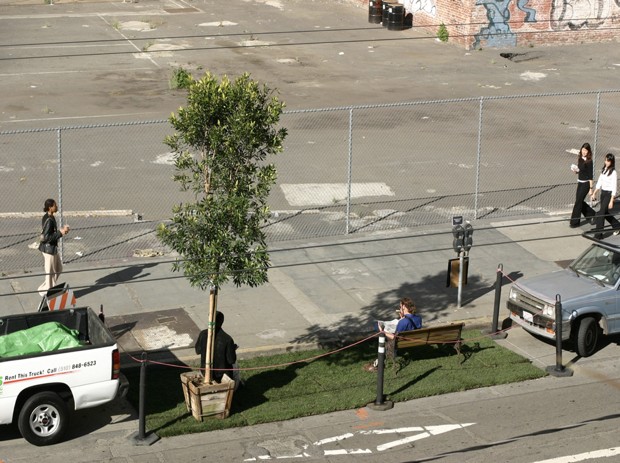Guerrilla strategies
Most everyday "things" are so common and stale. Thing on the street like benches or parking meters blend into the background unless someone is actively seeking it out. That's mainly because of the ubiquity of these objects. Of course not everything needs to stand out, but when it does, people notice and it has an impact.
Before our lecture, I was planning on writing about Park(ing) Day for my weekly blog post for this week. Park(ing) Day is a strategy in that it is working within the confines of what is allowed but in a innovative or clever way. Paying for a parking spot is an average daily experience. But paying for it an using it for something other than parking is not. Transforming a parking spot into a mini park creates a social spot out of an underappreciated piece of land. Throughout the years it has become a movement that allowed many cities to realize the potential in small urban parks.
In landscape architecture, there's another movement called "guerrilla gardening" that started in London where people would go out at night and plant flowers and shrubs in public spaces, or other spaces that they didn't technically own. It's usually done in neglected or abandoned areas in order to make them more aesthetic. It was citizens taking care of their neighborhoods in a way that would normally be prohibited.
Every person has a different everyday life. I think as architects we need to keep that in mind, and allow for people to use things in different ways or adapt the architecture to their needs. Sometimes it's important to break the rules of what's "allowed" in order to raise awareness of a problem or simply draw attention to alternative uses for everyday things.
Before our lecture, I was planning on writing about Park(ing) Day for my weekly blog post for this week. Park(ing) Day is a strategy in that it is working within the confines of what is allowed but in a innovative or clever way. Paying for a parking spot is an average daily experience. But paying for it an using it for something other than parking is not. Transforming a parking spot into a mini park creates a social spot out of an underappreciated piece of land. Throughout the years it has become a movement that allowed many cities to realize the potential in small urban parks.
In landscape architecture, there's another movement called "guerrilla gardening" that started in London where people would go out at night and plant flowers and shrubs in public spaces, or other spaces that they didn't technically own. It's usually done in neglected or abandoned areas in order to make them more aesthetic. It was citizens taking care of their neighborhoods in a way that would normally be prohibited.
Every person has a different everyday life. I think as architects we need to keep that in mind, and allow for people to use things in different ways or adapt the architecture to their needs. Sometimes it's important to break the rules of what's "allowed" in order to raise awareness of a problem or simply draw attention to alternative uses for everyday things.


Comments
Post a Comment